Habe es nun so ähnlich mithilfe einer Werteliste lösen können.
Kriege nun direkt in der Kachel eingeblendet, wo die Fenster noch offen sind.
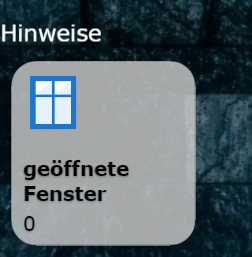
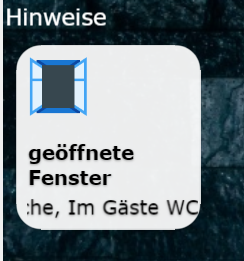
Habe es nun so ähnlich mithilfe einer Werteliste lösen können.
Kriege nun direkt in der Kachel eingeblendet, wo die Fenster noch offen sind.


@Glasfaser in der config war diggest hinterlegt, es hat ja auch sehr lange gut funktioniert.
@oliverio danke für den Tipp, habe zwar jetzt lange rumgemacht aber letztendlich durch folgende Schritte lösen können:
Bei JavaScript Adapter diggest-fetch gelöscht. Anschließend
npm uninstall node-fetch
Danach node-fetch@2 als NPM Modul in den Adaptereinstellungen eingefügt.
Hallo, seit einigen Monaten benutze ich einen Script um auf meinem Smartphone benachrichtigungen zu erhalten, wenn jemand unsere Haustür klingel benutzt. Leider funktioniert das Script seit dem 20.04.23 nicht mehr und ich erhalte die folgenden Errors, wenn ich das Script im Javascript Adapter starten möchte. Hat sich da vielleicht etwas geändert oder habt ihr vielleicht eine Ahnung wieso das Script nicht mehr funktioniert?
23:49:22.667 error javascript.0 (31732) script.js.common.Klingel: Error [ERR_REQUIRE_ESM]: require() of ES Module /opt/iobroker/node_modules/iobroker.javascript/node_modules/digest-fetch/digest-fetch-src.js from /opt/iobroker/node_modules/iobroker.javascript/lib/sandbox.js not supported.
23:49:22.667 info javascript.0 (31732) script.js.common.Klingel: registered 0 subscriptions, 0 schedules, 0 messages, 0 logs and 0 file subscriptions
23:49:22.668 error javascript.0 (31732) script.js.common.Klingel: TypeError: DigestFetch is not a constructor
23:49:22.668 error javascript.0 (31732) at new DahuaVTO (script.js.common.Klingel:88:26)
23:49:22.668 error javascript.0 (31732) at script.js.common.Klingel:517:1
23:49:22.668 error javascript.0 (31732) at script.js.common.Klingel:518:3
const DigestFetch = require('digest-fetch');
const net = require('net');
const fs = require('fs');
const path = require('path');
const md5 = require('md5');
const mqtt = require('mqtt');
/**
* Class to abstract a dahua doorbell.
*
* On instantiation it automatically connects with the doorbell, logs in and
* subscribes to all events.
*
* When an event is received, it forwards it to the MQTT broker so other systems
* can received those events. This behavior is very generic, users need to listen
* to those MQTT messages and create their own integrations using something like
* node-red for instance.
*
* In time this could be used to create a more user-friendly integration in home assistant,
* but a doorbell is a complicated device and I don't know enough yet to decide how such
* integration would look.
*/
class DahuaVTO {
deviceType;
serialNumber;
/**
* {Number} requestId
*
* Our Request / Response ID that must be in all requests and initated by us.
* This number auto-increments every time we send a message. Once we've logged in, every
* response contains the request id of which it's a response of, se it could be used to
* match responses with requests.
*
* I haven't bothered to do so because ,for what I saw, we only care about response order
* for the initial setup, and we do that on request at a time.
*
* If we ever make requests in parallel and we need to associate response to each request,
* we could use this. For not, it's just an auto-incremental number.
* */
requestId = 0;
// Session ID will be returned after successful login
/**
* {Number} sessionId
*
* When we try to log in on the doorbell we get a sessionId. From that point on every message
* we send over the socket needs to have include the sessionID for the doorbell to recognize us.
*/
sessionId = 0;
// Will be set after the login, but we initialize to 60s because it's a reasonable default
/**
* {Number} keepAliveInterval
*
* The number of seconds we have to space our keepAlive messages so the doorbell doesn't close
* the connection.
*/
keepAliveInterval = 60;
/**
* The ID returned by the `setInterval` call.
* We keep a reference in case we want to cancel it (maybe in case of failure?)
*/
_keepAliveTimer;
/**
* TCP socket to communicate with the doorbell external unit.
*/
doorbellSocket;
/**
* MQTT client to publish (and maybe receive) messages.
*/
mqttClient;
constructor() {
this.dahua_host = "xxxx";
this.dahua_username = "admin";
this.dahua_password = "xxxx";
this.mqtt_broker_host = "xxx";
this.mqtt_broker_port = "1884";
this.mqtt_broker_username = "xxx";
this.mqtt_broker_password = "xxxx";
this.mqtt_broker_topic_prefix = "DahuaVTO";
this.digestClient = new DigestFetch(
this.dahua_username,
this.dahua_password
);
this.getDeviceDetails().then(({ deviceType, serialNumber }) => {
this.deviceType = deviceType;
this.serialNumber = serialNumber;
this.start();
});
}
/**
* Starts the app by:
* - Opening a TCP socket to the doorbell
* - Connecting to the MQTT broker
* - Authenticating with the doorbell and subscribing to events.
*/
start() {
this.setupDoorbellSocket();
this.setupMQTT();
this.initLogin();
}
/**
* Makes a request to the doorbell using digest auth to retrieve the device's information.
*
* The information is returned in plain text (not JSON) that we have to parse.
* For now I think we only care about device type and serial number, which can be
* used to disambiguate in case we have more than one doorbell.
*/
async getDeviceDetails() {
return this.digestClient
.fetch(
`http://${this.dahua_host}/cgi-bin/magicBox.cgi?action=getSystemInfo`
)
.then((r) => r.text())
.then((text) => {
const deviceDetails = text
.trim()
.split('\n')
.reduce((obj, str) => {
const [key, val] = str.split('=');
obj[key] = val.trim();
return obj;
}, {});
return deviceDetails;
});
}
/**
* Saves a snapshot of the doorbells image into the given directory (defaults to /tmp/).
*
* By default the file is named with a simple timestamp of the current time (YYYY-MM-DD-H-M-S.jpg)
*
*/
saveSnapshot(p = '/tmp/') {
let now = new Date();
let dateStr = `${now.getFullYear()}-${
now.getMonth() + 1
}-${now.getDate()}-${now.getHours()}-${now.getMinutes()}-${now.getSeconds()}`;
let destination = path.join(p, `DoorBell_${dateStr}.jpg`);
this.digestClient
.fetch(`http://${this.dahua_host}/cgi-bin/snapshot.cgi`)
.then((r) => {
return r.buffer();
})
.then((buf) => {
fs.writeFile(destination, buf, 'binary', function (err) {
if (err) {
log('Error saving snapshot to disk', err);
} else {
log('Snapshot saved');
}
});
});
}
/**
* Creates the TCP socket connection with the doorbell on port 5000.
*
* Setups the listener for when we receive data over that socket
*
* Also setups other listeners for logging purposes mostly.
*
* If something goes wrong, we close everything and try to start over again.
*/
setupDoorbellSocket() {
let socket = new net.Socket({ readable: true, writable: true });
socket.on('end', function () {
log('Doorbell socket ended');
});
socket.on('close', function () {
log('Doorbell socket closed');
clearInterval(this._keepAliveTimer);
});
socket.on('data', this.receive.bind(this));
socket.on('error', function (e) {
log('Doorbell socket error', e);
this.doorbellSocket.destroy(); // destroy the socket
this.mqttClient.end(true); // End the mqtt connection right away.
clearInterval(this._keepAliveTimer); // Stop sending keepalive requests
this.start(); // Start over again.
});
this.doorbellSocket = socket.connect({ port: 5000, host: this.dahua_host });
}
/**
* Configure an initialize the MQTT client.
*
* It configures the "Last Will and Testament" (LWT), which is the message send to MQTT
* if this client gets disconnected in an ungraceful way (e.g. a fatal error).
*
* It also adds listeners that right now are only used for logging.
*/
setupMQTT() {
this.mqttClient = mqtt.connect({
host: this.mqtt_broker_host,
port: this.mqtt_broker_port,
username: this.mqtt_broker_username,
password: this.mqtt_broker_password,
will: {
topic: `${this.mqtt_broker_topic_prefix}/lwt`,
payload: 'connected',
qos: 1,
},
});
this.mqttClient.on('disconnect', function (packet) {
log('MQTTDisconnect', packet);
});
this.mqttClient.on('message', function (topic, message, packet) {
log('MQTTMessage', { topic, message, packet });
});
}
/**
* Publishes to MQTT an event with the given name and payload.
* @param {string} name
* @param {object} payload
*/
publishToMQTT(name, payload) {
let message = JSON.stringify(payload);
this.mqttClient.publish(
`${this.mqtt_broker_topic_prefix}/${name}/Event`,
message
);
}
/**
* Sends a message with the given data to the doorbell's outside unit using the TCP socket.
* @param {string} data
*
* This is a fairly low level way of communication, so let's dive in.
*
* We write binary to the socket, so we have to use buffers.
*
* The first 32 bytes of the message are the header.
* After the header we concat the actual message, which is a JSON string.
* The header has some bits that are fixed and others that are the length of the message that will
* come after.
*
* I didn't reverse-engineered this myself but it works. Take it as gospel as I did.
*/
send(data) {
let json = JSON.stringify(data);
let buf = Buffer.alloc(32);
let offset = buf.writeUInt32BE(0x20000000);
offset = buf.writeUInt32BE(0x44484950, offset);
offset = buf.writeDoubleBE(0, offset);
offset = buf.writeUInt32LE(json.length, offset);
offset = buf.writeUInt32LE(0, offset);
offset = buf.writeUInt32LE(json.length, offset);
offset = buf.writeUInt32LE(0, offset);
buf = Buffer.concat([buf, Buffer.from(json)]);
this.requestId += 1;
this.doorbellSocket.write(buf);
}
/**
* Handles received messages from the TCP socket.
* @param {Buffer} buf
*
* The received messages are binary. Once discarded the first 32 bytes (the header),
* the rest of the message is parsed as as a JSON string.
*
* The header contains the length of the received response in bytes 16..20 and the expected
* length of the response in bytes 24..28 in case we need it, but I haven't found a
* reason to. Perhaps responses might be sent in several chunks? So far it doesn't seem to be
* the case.
*
* Since we always make requests in the exact same order, we know the first two responses are
* for the authentication.
* Subsequent responses can be either events or keepalive responses.
*/
receive(buf) {
let str = buf.slice(32).toString();
let obj = JSON.parse(str);
if (this.requestId === 1) {
this.handleFirstLoginPayload(obj);
} else if (this.requestId === 2) {
this.handleSecondLoginPayload(obj);
} else if (obj.method === 'client.notifyEventStream') {
this.handleEvents(obj.params.eventList);
} else {
this.handleGenericPayload(obj);
}
}
/**
* Sends the initial login request.
* Note that does not include any password.
* The response to this request will be negative but that is expected, it will contain the
* necessary information to login.
*/
initLogin() {
this.send({
id: 10000,
magic: '0x1234',
method: 'global.login',
params: {
clientType: '',
ipAddr: '(null)',
loginType: 'Direct',
password: '',
userName: this.dahua_username,
},
session: 0,
});
}
/**
* Handles the response to the initial login request.
*
* The response contains a session ID, a realm and a random, which in combination with
* the username and the password are used to generate an MD5 password that is used
* for logging in.
*
* @param {object} payload
*/
handleFirstLoginPayload({ session, params: { random, realm } }) {
this.sessionId = session;
let randomHash = this.genMD5Hash(random, realm);
this.send({
id: 10000, // I assume this ID a high number just because we have to send something.
magic: '0x1234', // No idea what this is
method: 'global.login',
session: this.sessionId,
params: {
userName: this.dahua_username,
password: randomHash,
clientType: '',
ipAddr: '(null)',
loginType: 'Direct',
authorityType: 'Default',
},
});
}
/**
* Handles the response to the second (and last) response to login request.
*
* If successful, any subsequent message that includes the session id will be accepted for
* as long as the socket is not closed.
*
* To prevent the socket from closing we send a keepalive message every so often.
*
* Also now that we're authenticated we subscribe to all events fired by the doorbell.
*/
handleSecondLoginPayload(obj) {
if (obj.result) {
log('Logging to Dahua Doorbell successful');
this.keepAliveInterval = obj.params.keepAliveInterval - 5;
this.attachEventManager();
this.keepConnectionAlive();
} else {
log('Failed to login. Response was: ', obj);
}
}
/**
* Handles any response not handled by any other method. I believe only keepalive responses
* will end up here, but added some logging just in case.
*
* For now keepalive events are published to MQTT, but I don't see a good reason for that.
*/
handleGenericPayload(obj) {
if (
obj.result === true &&
obj.params &&
Object.hasOwnProperty.call(obj.params, 'timeout')
) {
log('Publish KeepAlive event');
this.publishToMQTT('keepAlive', {
deviceType: this.deviceType,
serialNumber: this.serialNumber,
});
} else {
log(
'handleGenericPayload# Cannot handle received payload',
obj
);
}
}
/**
* Generates a MD5 digest of the username, password, realms and random to send as
* password when logging in.
* @param {*} random
* @param {*} realm
*/
genMD5Hash(random, realm) {
const base_credentials = `${this.dahua_username}:${realm}:${this.dahua_password}`;
const pwddb_hash = md5(base_credentials).toUpperCase();
const base_pass = `${this.dahua_username}:${random}:${pwddb_hash}`;
return md5(base_pass).toUpperCase();
}
/**
* Sends the message to subscribe to all dorbell events.
*/
attachEventManager() {
this.send({
id: this.requestId,
magic: '0x1234',
method: 'eventManager.attach',
params: {
codes: ['All'],
},
session: this.sessionId,
});
}
/**
* Handles the events sent by the doorbell.
*
* It just publishes those events along with some information of the device firing them
* to MQTT
*/
handleEvents(events) {
events.forEach((event) => {
log(`Publish event ${event.Code} to MQTT`);
this.publishToMQTT(event.Code, {
Action: event.eventAction,
Data: event.Data,
deviceType: this.deviceType,
serialNumber: this.serialNumber,
});
});
}
/**
* Sets up a function to be called periodically to keep the socket open by sending
* keepalive messages.
* @param {Number} delay (in seconds)
*/
keepConnectionAlive(delay) {
this._keepAliveTimer = setInterval(() => {
let keepAlivePayload = {
method: 'global.keepAlive',
magic: '0x1234',
params: {
timeout: delay,
active: true,
},
id: this.requestId,
session: this.sessionId,
};
this.send(keepAlivePayload);
}, this.keepAliveInterval * 1000);
}
/**
* Remotely triggers the relay 1 (e.g. to open an electric gate).
*
* In my VTO 2202 F this also triggers the voice announcing the the door has been opened.
*/
openDoor() {
return this.digestClient
.fetch(
`http://${this.dahua_host}/cgi-bin/accessControl.cgi?action=openDoor&channel=1&UserID=101&Type=Remote`
)
.then((r) => {
if (r.ok) {
log('Door relay triggered');
} else {
log('Error triggering the door relay', e);
}
})
.catch(e => log('Connection error triggering the door relay'));
}
// requestMissedCallsLog() {
// this.send({
// id: this.requestId,
// magic: '0x1234',
// method: 'RecordFinder.factory.create',
// params: {
// name: 'VideoTalkMissedLog',
// },
// session: this.sessionId,
// });
// }
// requestMissedCallsLog2(findToken) {
// this.send({
// id: this.requestId,
// magic: '0x1234',
// method: 'RecordFinder.startFind',
// object: findToken,
// params: { condition: null },
// session: this.sessionId,
// });
// }
// requestMissedCallsLog3(findToken) {
// this.send({
// id: this.requestId,
// magic: '0x1234',
// method: 'RecordFinder.doFind',
// object: findToken,
// params: { count: 3 }, // Number of calls to show
// session: this.sessionId,
// });
// }
};
exports.default = DahuaVTO;
new DahuaVTO();
Danke für deine Antwort. Mit dem Nicknamen habe ich bereits probiert, leider dasselbe Problem.
Habe leider genau dasselbe Problem. Hast du es bereits lösen können?
Über die Webseite funktioniert es, jedoch über iobroker nicht.
Bei mir steht ebenfalls, User is not in the whitelist.
Habe es nun so ähnlich mithilfe einer Werteliste lösen können.
Kriege nun direkt in der Kachel eingeblendet, wo die Fenster noch offen sind.


Habe nun endlich ein Script zum Zählen der Fenster zum laufen bekommen.
Das Script setzte einmal einen Datenpunkt auf true/false falls ein Fenster geschlossen ist und schreibt in einem anderen Datenpunkt, wo genau die Fenster noch offen sind.
Eine Frage hätte ich noch bezüglich der Darstellung in iQontrol.
Ist es irgendwie möglich, diesen rot markierten Text direkt in der Kachel, unter dem Text "geöffnet" darzustellen? So, dass ich auf einem Blick sehe wo genau das Fenster noch offen ist? Einen Datenpunkt habe ich ja bereits wo angegeben wird, wo die Fenster offen sind.
Muss es nur irgendwie in das Kachel kriegen.


So sieht meine derzeitige Einstellung in iQontrol aus.
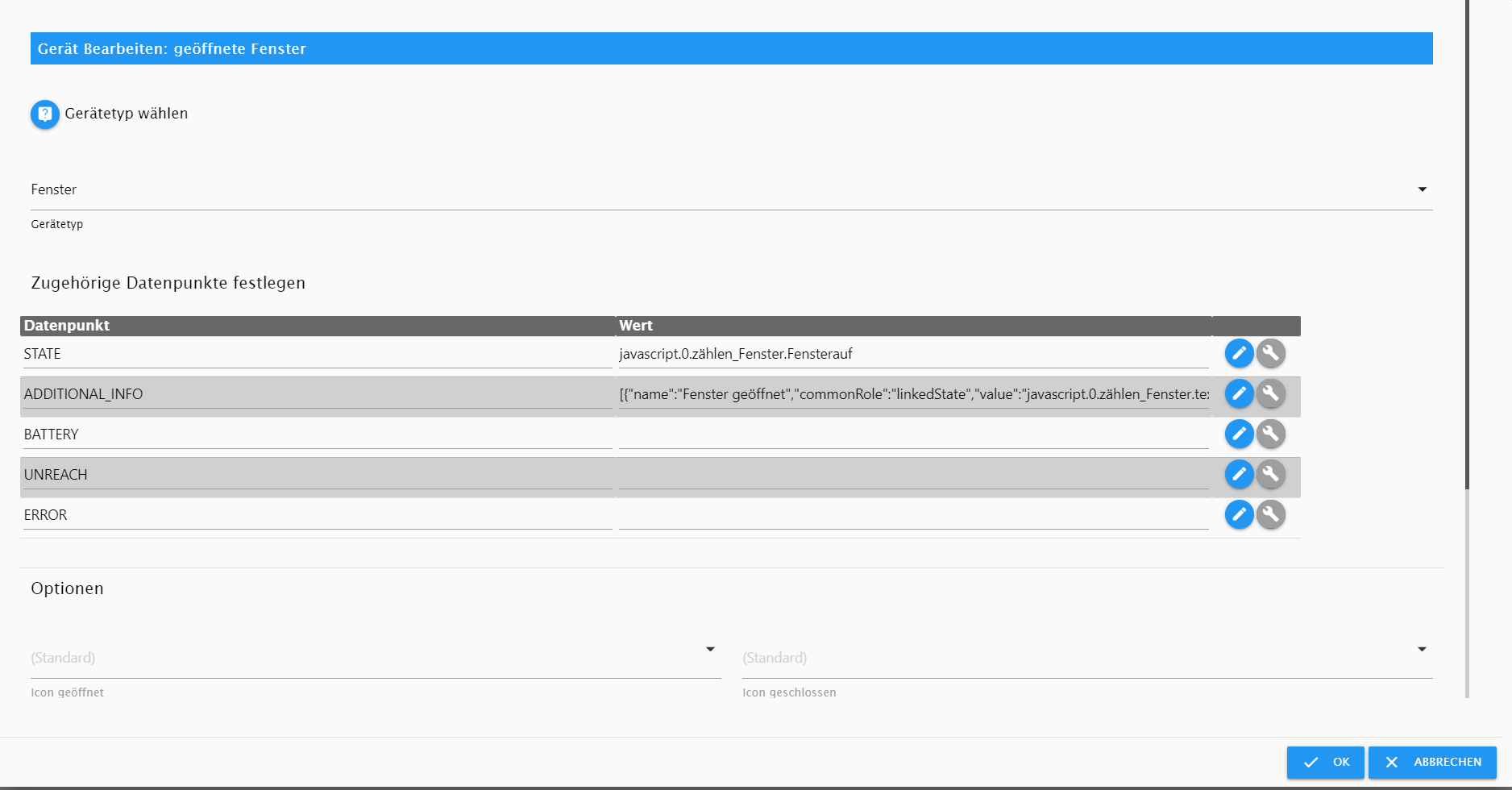
Vielen Dank im Voraus
@dslraser
hatte es nur mehrfach gestartet & gestoppt gehabt.
Habe bereits aus Verzweiflung das Script von dieser Seite versucht.
https://www.smarthome-tricks.de/software-iobroker/iobroker-aufzaehlungen-fuer-das-zaehlen-von-offenen-fenstern-oder-tueren-verwenden/
Hier werden die Werte zwar richtig übernommen, jedoch muss ich jedes mal das Script neustarten damit die Datenpunkte aktualisiert werden.
Vielen Dank für die Antwort.
Leider funktioniert es immernoch nicht. Habe nach der Änderung beides neugestartet.
Hoffe ich habe es richtig editiert.
Hättest du vielleicht noch eine Idee?
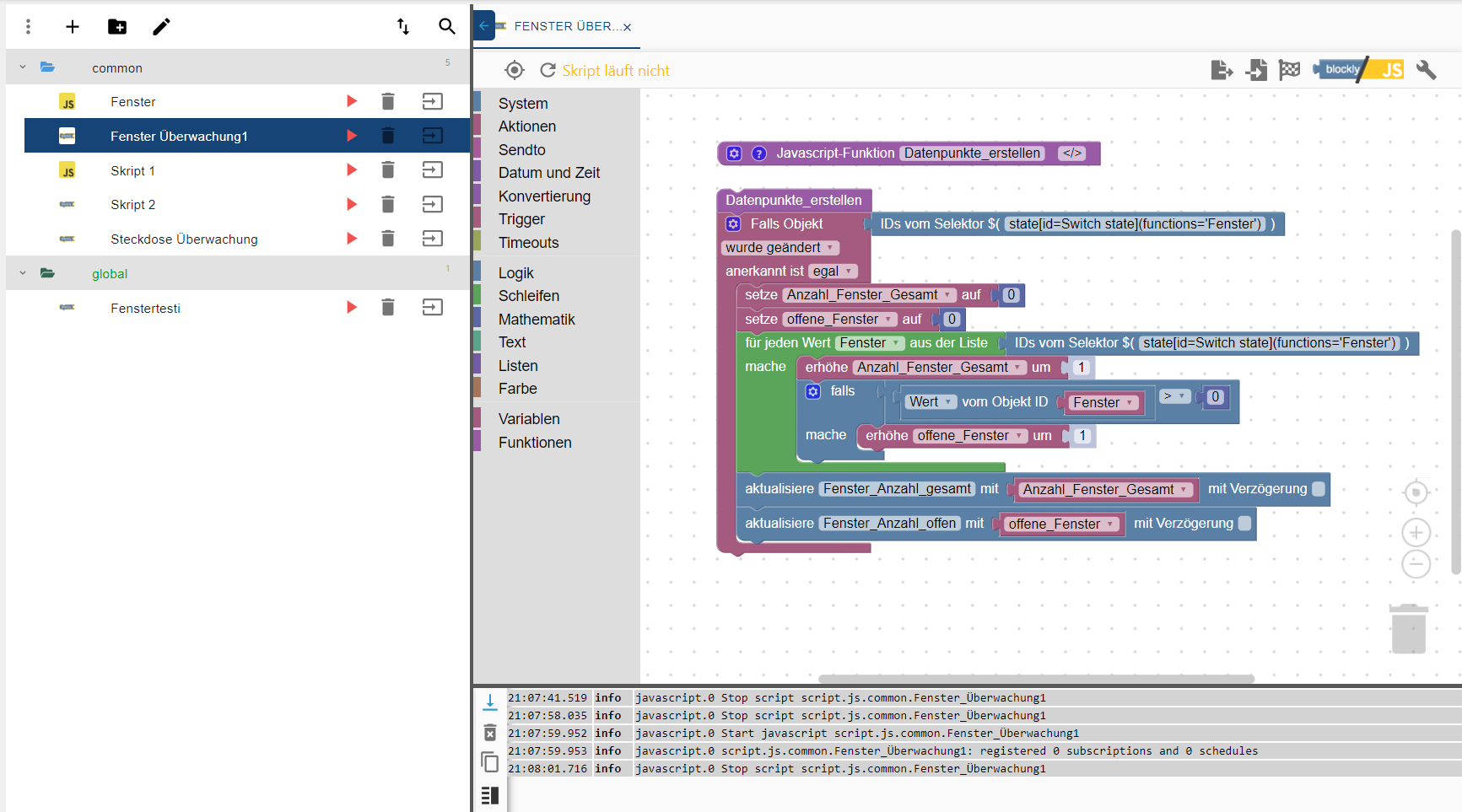
Erstmal vielen Dank für den Adapter, finde ihn gerade für Anfänger wie mich wirklich ideal. Sieht sehr ansprechend aus und bringt sehr viele Funktionen mit.
Ich versuche gerade das Script für das Zählen der Fenster zum laufen zu kriegen, scheitere jedoch dabei.
Da meine Fenster-Sensoren noch nicht angekommen sind, wollte ich das Script mithilfe meiner 2 Osram Plugs ausprobieren.
Sprich das Script sollte die Anzahl der eingeschalteten Plugs erkennen und mir die Werte in einem Datenpunkt hinterlegen.
Ich versuche derzeit das Blockly Script von @dslraser aber scheitere vermutlich bei dem Baustein "IDs vom Selektor ". Könnt mir bitte jemand einen Tipp geben, welchen befehl ich genau in dem Baustein verwenden muss?
Der Befehl mit channel[state.id.....] funktioniert leider nicht, habe es auch bereits mit dem auf dem Bild zu sehenden Befehl versucht, jedoch erfolglos...
Hoffe ihr könnt mir helfen.
Mein derzeitiges Blockly Script (abgespeichert in "Common")
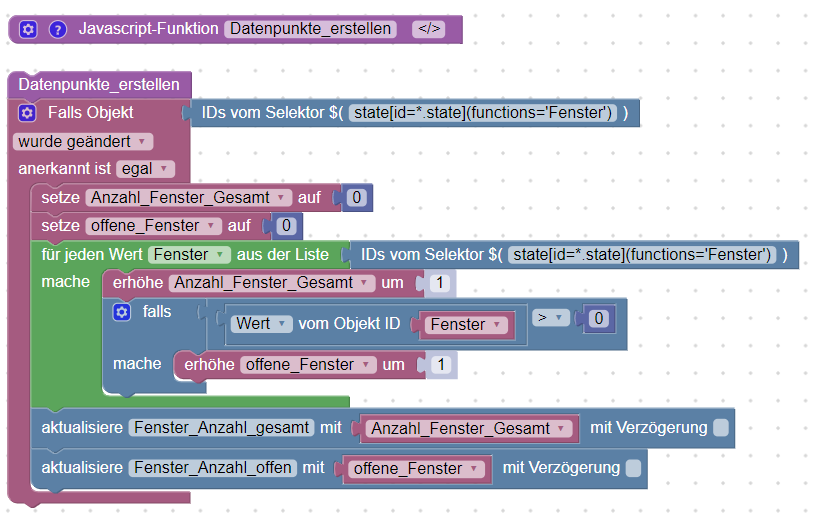
Objekt Übersicht des Osram Plugs

RAW

Aufzählungen
